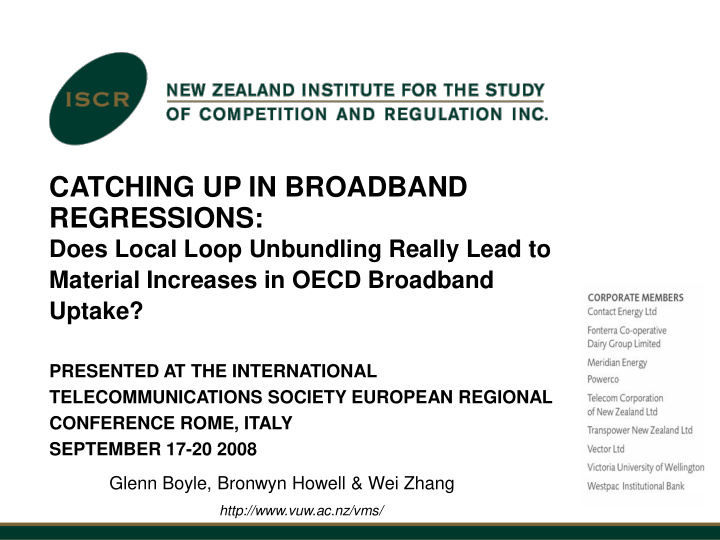



CATCHING UP IN BROADBAND REGRESSIONS: Does Local Loop Unbundling Really Lead to Material Increases in OECD Broadband Uptake? PRESENTED AT THE INTERNATIONAL TELECOMMUNICATIONS SOCIETY EUROPEAN REGIONAL CONFERENCE ROME, ITALY SEPTEMBER 17-20 2008 Glenn Boyle, Bronwyn Howell & Wei Zhang http://www.vuw.ac.nz/vms/
BROADBAND UPTAKE Broadband – ‘frontier’ technology to access the internet – widely perceived as a factor driving economic growth potential Broadband uptake per capita – widely used by policy-makers to benchmark relative potential of different countries to garner economic benefits of the internet – rightly or wrongly, higher national levels presumed to indicate • superior performance in the emerging ‘internet economy’ • greater potential to benefit from economic gains perceived to be available
INTERNATIONAL ‘COMPETITION’ OECD countries ‘competing’ to ‘win’ the ‘information economy stakes’ – scouring respective policy environments to determine factors deemed to contribute to the winners’ ‘success’ – looking for a ‘policy lever’ to pull to ‘catch up’ with the leaders Local Loop Unbundling (LLU) identified as a ‘likely lever’ – theoretically stimulates uptake by increasing product variety and putting price pressure on incumbents by enabling entry – but may reduce incentives for incumbent to invest and delays investment by entrants in stand-alone infrastructures – spawned a body of econometric research into its effects on broadband uptake
EXAMINING THE EVIDENCE Limited Yields varying conclusions – a small, statistically insignificant positive effect ( Distaso,Lupi & Manenti, 2006; Kim, Bauer & Wildman, 2003; Cava-Ferruela & Alabau-Munoz, 2006) – a small effect neither consistently positive nor consistently statistically significant effect (Wallsten, 2006) – a small transient effect (Denni & Gruber, 2005) Two lines of thinking – LLU is not a significant factor in driving broadband uptake – it is significant, but the effect has not yet shown up in analyses undertaken using ‘early’ data collected before LLU became widespread
A RECENT ANALYSIS IS SIGNIFICANT OECD (2007) using 2002 and 2005 data – OECD has encouraged use of LLU as a policy tool Finds a positive and statistically significant effect Concludes “unbundling….is currently more significant than platform competition in explaining broadband penetration” Recommends “(t)his fact suggests that if platform competition does not materialise, government or regulatory policy aimed at increasing broadband penetration rates should focus on determining the appropriate pricing structure for the unbundled local loop or consider the use of subsidies to increase broadband infrastructure or penetration rates”
ARE THE FINDINGS RELIABLE? Will not affect policy decisions in 28 OECD countries already adopting LLU But may influence those countries (OECD and non- OECD) who have not yet adopted May affect development of access policies with respect to other infrastructures (e.g. fibre)
THE OECD MODEL QTOT = α + βGUYRS + γX + ε QTOT = broadband connections per 100 population GUYRS = number of years since the implementation of local loop unbundling X is a vector of control variables that potentially affect broadband uptake (price, user age, urbanisation, competition, dummy for data year) Data – 54 observations: 30 from 2005; 24 from 2002 Estimation using Ordinary Least Squares
THE OECD (2007) FINDINGS 2005 data alone – statistically significant estimates of β only for models excluding price – suggests unbundling proxy GUYRS simply capturing more fundamental price effects 2002 & 2005 panel data – β positive and statistically significant at the 1% level in two models – coefficients range between 0.59 and 0.65 – findings lead to the strongly-voiced conclusions supporting LLU as a ‘policy lever’ enabling laggard countries to ‘catch up’ to OECD broadband uptake leaders
THE ECONOMETRIC PROBLEM Residual clustering in panels can result in OLS standard errors containing significant bias – over-stated t -statistics (Petersen, 2007) Potential for time-series clustering of residuals in OECD panel data is high – 2005 broadband observations for each country likely to be related to their 2002 counterparts Must exclude this possibility before accepting OECD (2007) conclusions – re-estimate using robust standard errors (Arellano, 1987; Petersen, 2007)
ADJUSTING FOR WITHIN-COUNTRY CORRELATION Little difference to the precision with which most variable coefficients are estimated But one striking difference: IN BOTH MODELS, GUYRS COEFFICIENT ESTIMATE IS STATISTICALLY INSIGNIFICANT AT CONVENTIONAL LEVELS THE APPARENT EXPLANATORY POWER OF LOCAL LOOP UNBUNDLING FOR BROADBAND PENETRATION DISAPPEARS
BUT COULD LLU STILL BE IMPORTANT? Small data set, rapid technological change, considerable ‘noise’ Positive coefficient, even though imperfectly estimated, may be evidence of a real economic phenomenon
QUANTITATIVE SIGNIFICANCE OF THE POSITIVE COEFFICIENT 0.59 to 0.65 connections per 100 per year of unbundling availability – population of 20 million => additional 118,000 to 130,000 connections in first year following unbundling But coefficient on year dummy is 3.6 to 3.8 times the size of the coefficient on GUYRS SIMPLE PASSING OF TIME HAS SUBSTANTIALLY GREATER EFFECT UPON BROADBAND UPTAKE LEVELS THAN LLU (MEASURED AS GUYRS)
TIME MATTERS FOR TECHNOLOGY DIFFUSION GUYRS likely picking up effects attributable to the time- based diffusion of the technology Two-stage test 1. Replace GUYRS with a dummy (1-0 yes-no) if LLU in place in the year in question • coefficients insignificantly different from zero • explanatory power of GUYRS is predominantly its time- varying effect and not its unbundling effect 2. Add a variable to capture time broadband available • coefficient of GUYRS falls to 75% of previous estimate • GUYRS not statistically significant (but length of time broadband has been available is)
CONCLUSION Using the model from OECD (2007), the contribution of LLU to national levels of broadband uptake is – materially small – statistically insignificant The effects found for it are largely spurious – reflect impact of increasing diffusion, not policy interventions Unless or until further evidence is produced, the paper cannot be used to justify unbundling as a policy to increase broadband uptake
Recommend
More recommend